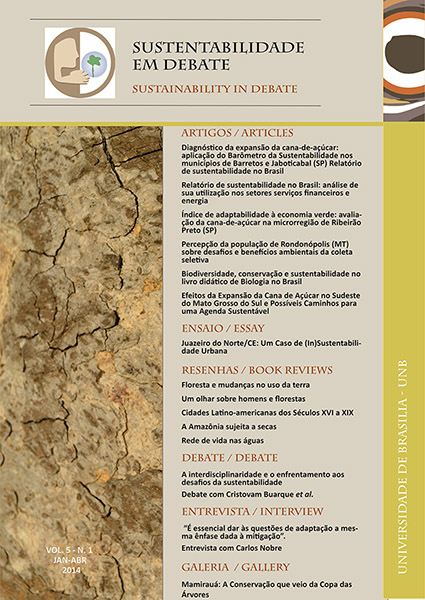Diagnóstico da expansão da cana-de-açúcar:
aplicação do Barômetro da Sustentabilidade nos municípios de Barretos e Jaboticabal (SP)
DOI:
https://doi.org/10.18472/SustDeb.v5n1.2014.9418Palavras-chave:
Bioetanol, Cana-de-açúcar, Sustentabilidade, Barômetro da SustentabilidadeResumo
Para reduzir emissões dos gases do efeito estufa e aumentar a segurança de suprimento energético, o interesse internacional por biocombustíveis tem crescido consideravelmente nos últimos anos. Com a crescente demanda e consequente expansão da produção, é inquestionável a necessidade de avaliar os impactos sobre a sociedade e o meio ambiente. O Brasil, com grandes áreas agricultáveis e a grande produção de cana-de-açúcar, além do conhecimento agregado por décadas de pesquisa e produção de bioetanol, possui potencial para expansão, mas as consequências devem ser analisadas além da simples viabilidade econômica. Para uma avaliação de impactos sociais da atividade canavieira foi aplicada a metodologia conhecida como Barômetro da Sustentabilidade para dois municípios do estado de São Paulo: um com forte expansão canavieira (Barretos), e outro com produção estagnada (Jaboticabal) no mesmo período de 10 anos. Com a comparação dos indicadores dos dois municípios buscou-se identificar a causalidade em relação à expansão da cultura em estudo. A aplicação do Barômetro da Sustentabilidade indica um impacto ambiental negativo no município com significativa expansão canavieira. Além disso, o município sem expansão teve melhora em seu desempenho de bem-estar humano, contra uma estabilização do indicador no município em que houve expansão.
Downloads
Referências
M. P. Remote sensing time series to evaluate direct land use change of recent
expanded sugarcane crop in Brazil. Sustainability, 4:574-585. 2012.
ARAÚJO, G.c. et al. Diagnosis of sustainability in the Brazilian city of Touros: An
application of the barometer of sustainability. Holos, Natal, v. 2, n. 29, p.161-171,
abr. 2013.
CANASAT. Monitoramento da Cana-de-açúcar via imagens de satélite. Disponível
em: http://www.dsr.inpe.br/laf/canasat/. Acesso em: 5 de dezembro de 2012.
COMPANHIA NACIONAL DE ABASTECIMENTO (CONAB). Acompanhamento de safra
brasileira: cana-de-açúcar, terceiro levantamento, safra 2011/2012. Brasília, 2011.
Disponível em: http://www.conab.gov.br/OlalaCMS/uploads/arquivos/
12_12_12_10_34_43_boletim_cana_portugues_12_2011.pdf. Acesso em: 13 de abril
2012.
EMPRESA BRASILEIRA DE PESQUISA AGROPECUÁRIA (Embrapa). Zoneamento
agroecológico da cana-de-açúcar. Embrapa Solos, Rio de Janeiro, 2009. 55 p.
EMPRESA DE PESQUISA ENERGÉTICA (EPE), Ministério de Minas e Energia (MME).
Plano Decenal de Expansão de Energia 2021. Ministério de Minas e Energia,
Empresa de Pesquisa Energética, Brasília, Brazil, 2012. 387 p.
GRAYMORE, Michelle L. M.; SIPE, Neil G.; ROCKSON, Roy E.. Regional sustainability:
How useful are current tools of sustainability assessment at the regional scale?.
Ecological Economics, Victoria, n. 67, p.362-372, jul. 2008.
GUIMARÃES, Lucy Teixeira; TURETTA, Ana Paula Dias; COUTINHO, Heitor Luiz da
Costa. Uma proposta para avaliar a sustentabilidade da expansão do cultivo da
cana-de-açúcar no estado do Mato Grosso do Sul. Sociedade&natureza;,
Uberlândia, v. 2, n. 22, p.313-327, ago. 2010.
INSTITUTO BRASILEIRO DE GEOGRAFIA E ESTATÍSTICA (IBGE). Área territorial oficial
- 2010. Resolução da Presidência do IBGE de n° 5 (R.PR-5/02). Disponível em: http:/
/www.ibge.gov.br/home/geociencias/areaterritorial/area.shtm. Acesso em: 15 de
maio de 2013.
INSTITUTO BRASILEIRO DE GEOGRAFIA E ESTATÍSTICA (IBGE). Mapa de biomas do
Brasil. Diretoria de Geociências, São Paulo, 2004.
INSTITUTO BRASILEIRO DE GEOGRAFIA E ESTATÍSTICA (IBGE). Sistema IBGE de
Recuperação Automática (SIDRA). Disponível em: http://www.sidra.ibge.gov.br/
bda/agric/. Acesso em: 15 de maio de 2013.
KRONEMBERGER, Denise Maria Penna et al. Desenvolvimento sustentável no Brasil:
Uma análise a partir da aplicação do Barômetro da Sustentabilidade.
Sociedade&natureza, Uberlândia, n. , p.25-50, jun. 2008.
PRESCOTT-ALLEN, R. The well-being of nations: A country-by-Country Index of
Quality of Life and the Environment. Island Press, Washington, DC. 342 p. 2001.
RONQUIM, C. C. Queimada na colheita de cana-de-açúcar: impactos ambientais,
sociais e econômicos. Campinas: Embrapa, 2010. 45 p.
TROCHIM, W. M. K. Establishing a Cause-Effect Relationship. Disponível em: http:/
/www.socialresearchmethods.net/kb/causeeff.php. Acesso em: 30 de junho de
2013.
UNIÃO DA INDÚSTRIA DE CANA-DE-AÇÚCAR (UNICA). Dados e Cotações ”“
Estatísticas, Produção Brasil, 2009. Disponível em: http://www.unica.com.br/
dadosCotacao/ estatistica. Acesso em: 10 de maio de 2012.
Downloads
Publicado
Como Citar
Edição
Seção
Licença
A submissão de trabalho(s) científico(s) original(is) pelos autores, na qualidade de titulares do direito de autor do(s) texto(s) enviado(s) ao periódico, nos termos da Lei 9.610/98, implica na cessão de direitos autorais de publicação impressa e/ou digital à Revista Sustentabilidade em Debate do(s) artigo(s) aprovado(s) para fins da publicação, em um único número da Revista, autorizando-se, ainda, que o(s) trabalho(s) científico(s) aprovado(s) seja(m) divulgado(s) gratuitamente, sem qualquer tipo de ressarcimento a título de direitos autorais, por meio do site da Revista, para fins de leitura, impressão e/ou download do arquivo do texto, a partir da data de aceitação para fins de publicação. Portanto, os autores ao procederem a submissão do(s) artigo(s) Revista, e, por conseguinte, a cessão gratuita dos direitos autorais relacionados ao trabalho científico enviado, têm plena ciência de que não serão remunerados pela publicação do(s) artigo(s) no periódico.
A Revista encontra-se licenciada sob uma Licença Creative Commons Atribuição-NãoComercial-SemDerivações (Proibição de Realização de Obras Derivadas) 3.0 Brasil, para fins de difusão do conhecimento científico, conforme indicado no sítio da publicação, que permite o compartilhamento do texto e o reconhecimento de sua autoria e publicação original nesta revista.
Os autores têm permissão para assumir contratos adicionais separadamente, para distribuição não-exclusiva dos trabalhos publicados na Revista Sustentabilidade em Debate (por exemplo, em um capítulo de livro), desde que seja assinalado que os textos foram originalmente publicados nesta revista e que seja mencionado o DOI correspondente. Os autores têm permissão e são estimulados a publicar e distribuir o seu texto online, após a publicação (por exemplo, em repositórios institucionais ou nas suas páginas pessoais).
Os autores declaram expressamente concordar com os termos da presente Declaração de Direito Autoral, que se aplicará a submissão caso seja publicada por esta Revista.






